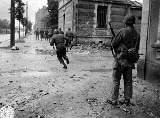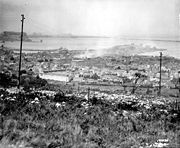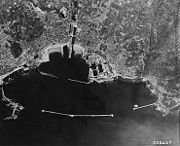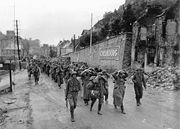
Battle of Cherbourg
Encyclopedia
The Battle of Cherbourg was part of the Battle of Normandy
during World War II
. It was fought immediately after the successful Allied
landings on June 6, 1944. American troops isolated and then captured the fortified port, considered vital to the campaign in Western Europe, in a hard-fought campaign of 2 months.
 When they drew up their plans for the invasion of France, the Allied staff considered that it would be necessary to secure a deep-water port to allow reinforcements to be brought directly from the United States. (Without such a port, equipment packed for transit would first have to be unloaded at a port in Great Britain, unpacked, water-proofed and then reloaded onto landing craft to be transferred to France). Cherbourg, at the end of the Cotentin Peninsula
When they drew up their plans for the invasion of France, the Allied staff considered that it would be necessary to secure a deep-water port to allow reinforcements to be brought directly from the United States. (Without such a port, equipment packed for transit would first have to be unloaded at a port in Great Britain, unpacked, water-proofed and then reloaded onto landing craft to be transferred to France). Cherbourg, at the end of the Cotentin Peninsula
, was the largest, accessible port from the landings.
The Allied planners decided at first not to land directly on the Cotentin Peninsula, since this sector would be separated from the main Allied landings by the Douve River valley, which had been flooded by the Germans
to deter airborne landings. On being appointed overall land commander for the invasion in January 1944, British General Bernard Montgomery reinstated the landing on the Cotentin peninsula, partly to widen the front and therefore prevent the invaders becoming sealed into a narrow lodgement, but also to enable a rapid capture of Cherbourg.
 In the early hours of June 6, the US 82nd
In the early hours of June 6, the US 82nd
and 101st Airborne Division
s landed at the base of the Cotentin Peninsula. Although the landings were scattered, they nevertheless secured most of the routes by which the US VII Corps would advance from Utah Beach
. The US 4th Infantry Division landed on Utah Beach shortly after dawn with few casualties.
In the immediate aftermath of the landings the priority for the invasion forces at Utah Beach was to link up with the main Allied landings further west. On June 9, the 101st Airborne Division managed to cross the Douve River valley and captured Carentan
the next day. In vicious house-to-house fighting (the Battle of Carentan
), the airborne troops were able to take the town, ensuring the Allies a continuous front. The front was maintained despite a German counterattack reinforced by armored units on the 13th, known as the Battle of Bloody Gulch.
 This success allowed VII Corps to advance westwards to cut off the Cotentin Peninsula. An additional three infantry divisions had landed to reinforce the Corps. Major General J. Lawton Collins
This success allowed VII Corps to advance westwards to cut off the Cotentin Peninsula. An additional three infantry divisions had landed to reinforce the Corps. Major General J. Lawton Collins
, the Corps Commander, drove his troops hard, replacing units in the front lines or sacking officers if progress was slow.
The Germans facing VII Corps were a mix of regiments and battlegroups from several divisions, many of which had already suffered heavy casualties fighting the American airborne troops in the first days of the landings. Practically no German armored or mobile troops could be sent to this part of the front because of the threat to Caen
further east. Infantry reinforcements arrived only slowly. Tactically, the Germans' flooding of the Douve worked against them because it secured the Allied southern flank.
By June 16, there were no further natural obstacles in front of the American forces. The German command was in some confusion. The commanders (including Field Marshal Erwin Rommel
) wished to withdraw their troops in good order into the Atlantic Wall
fortifications of Cherbourg, where they could have withstood a siege for some time. Adolf Hitler
, issuing orders from his headquarters in East Prussia
, demanded that they hold their present lines even though this risked disaster.
Late on June 17, Hitler agreed that the troops might withdraw but specified that they were to occupy a new, illogical defensive line, spanning the entire peninsula just south of Cherbourg. Rommel protested against this order, but he nevertheless dismissed General Farmbacher, commanding the LXXXIV Corps, who he thought was trying to circumvent it.
 On June 18, the US 9th Infantry Division reached the west coast of the peninsula. Within 24 hours, the 4th, 9th and 79th Infantry Divisions were driving north on a broad front. There was almost no opposition on the western side of the peninsula; on the eastern side, the exhausted defenders around Montebourg
On June 18, the US 9th Infantry Division reached the west coast of the peninsula. Within 24 hours, the 4th, 9th and 79th Infantry Divisions were driving north on a broad front. There was almost no opposition on the western side of the peninsula; on the eastern side, the exhausted defenders around Montebourg
collapsed. Several large caches of V-1 flying bomb
s were discovered by the Americans in addition to a V-2 rocket
installation at Brix
.
In two days, the American divisions were within striking distance of Cherbourg. The garrison commander, Lieutenant General Karl-Wilhelm von Schlieben
, had 21,000 men but many of these were hastily drafted naval personnel or from labour units. The fighting troops who had retreated to Cherbourg (including the remnants of von Schlieben's own Division, the 709th), were tired and disorganised. Food, fuel and ammunition were short. The Luftwaffe
dropped a few supplies, but these were mostly items such as Iron Cross
es, intended to bolster the garrison's morale. Nevertheless, von Schlieben rejected a summons to surrender and began carrying out demolitions to deny the port to the Allies.
Collins launched a general assault on June 22. Resistance was stiff at first, but the Americans slowly cleared the Germans from their bunkers and concrete pillboxes. Allied Naval ships bombarded fortifications near the city
on June 25. On June 26, the 79th Division captured Fort du Roule, which dominated the city and its defenses. This finished any organised defense. Von Schlieben was captured. The harbor fortifications and the Arsenal surrendered a few days later, after token resistance. Some German troops cut off outside the defenses held out until July 1.
 The Germans had so thoroughly wrecked and mined Cherbourg that Hitler awarded the Knight's Cross
The Germans had so thoroughly wrecked and mined Cherbourg that Hitler awarded the Knight's Cross
to Rear Admiral Walter Hennecke
the day after he surrendered for "a feat unprecedented in the annals of coastal defense." The port was not brought into limited use until the middle of August; although the first ships were able to use the harbor in late July. Nevertheless, the Germans had sustained a major defeat, as a result of a rapid Allied buildup on their western flank and Hitler's rigid orders.
General Friedrich Dollman, commanding the German Seventh Army
, died of a heart attack on June 28, having just been informed of a court martial pending as a result of the capture of Cherbourg.
Operation Overlord
Operation Overlord was the code name for the Battle of Normandy, the operation that launched the invasion of German-occupied western Europe during World War II by Allied forces. The operation commenced on 6 June 1944 with the Normandy landings...
during World War II
World War II
World War II, or the Second World War , was a global conflict lasting from 1939 to 1945, involving most of the world's nations—including all of the great powers—eventually forming two opposing military alliances: the Allies and the Axis...
. It was fought immediately after the successful Allied
Allies of World War II
The Allies of World War II were the countries that opposed the Axis powers during the Second World War . Former Axis states contributing to the Allied victory are not considered Allied states...
landings on June 6, 1944. American troops isolated and then captured the fortified port, considered vital to the campaign in Western Europe, in a hard-fought campaign of 2 months.
Allied plans

Cotentin Peninsula
The Cotentin Peninsula, also known as the Cherbourg Peninsula, is a peninsula in Normandy, forming part of the north-western coast of France. It juts out north-westwards into the English Channel, towards Great Britain...
, was the largest, accessible port from the landings.
The Allied planners decided at first not to land directly on the Cotentin Peninsula, since this sector would be separated from the main Allied landings by the Douve River valley, which had been flooded by the Germans
Germany
Germany , officially the Federal Republic of Germany , is a federal parliamentary republic in Europe. The country consists of 16 states while the capital and largest city is Berlin. Germany covers an area of 357,021 km2 and has a largely temperate seasonal climate...
to deter airborne landings. On being appointed overall land commander for the invasion in January 1944, British General Bernard Montgomery reinstated the landing on the Cotentin peninsula, partly to widen the front and therefore prevent the invaders becoming sealed into a narrow lodgement, but also to enable a rapid capture of Cherbourg.
Landings

U.S. 82nd Airborne Division
The 82nd Airborne Division is an active airborne infantry division of the United States Army specializing in parachute landing operations. Based at Fort Bragg, North Carolina, the 82nd Airborne Division is the primary fighting arm of the XVIII Airborne Corps....
and 101st Airborne Division
101st Airborne Division
The 101st Airborne Division—the "Screaming Eagles"—is a U.S. Army modular light infantry division trained for air assault operations. During World War II, it was renowned for its role in Operation Overlord, the D-Day landings on 6 June 1944, in Normandy, France, Operation Market Garden, the...
s landed at the base of the Cotentin Peninsula. Although the landings were scattered, they nevertheless secured most of the routes by which the US VII Corps would advance from Utah Beach
Utah Beach
Utah Beach was the code name for the right flank, or westernmost, of the Allied landing beaches during the D-Day invasion of Normandy, as part of Operation Overlord on 6 June 1944...
. The US 4th Infantry Division landed on Utah Beach shortly after dawn with few casualties.
In the immediate aftermath of the landings the priority for the invasion forces at Utah Beach was to link up with the main Allied landings further west. On June 9, the 101st Airborne Division managed to cross the Douve River valley and captured Carentan
Carentan
Carentan is a small rural town near the north-eastern base of the French Cotentin Peninsula in Normandy in north-western France near the port city of Cherbourg-Octeville. Carentan has a population somewhat over 6,000 and is now administratively organized as a commune in the Manche department...
the next day. In vicious house-to-house fighting (the Battle of Carentan
Battle of Carentan
The Battle of Carentan was an engagement in World War II between airborne forces of the United States Army and the German Wehrmacht during the Battle of Normandy. The battle took place between 10 and 15 June 1944, on the approaches to and within the city of Carentan, France.The objective of the...
), the airborne troops were able to take the town, ensuring the Allies a continuous front. The front was maintained despite a German counterattack reinforced by armored units on the 13th, known as the Battle of Bloody Gulch.
Move across the Cotentin Peninsula

J. Lawton Collins
Joseph "Lightning Joe" Lawton Collins was a General in the United States Army. During World War II, he served in both the Pacific and European Theaters of Operations. His elder brother, James Lawton Collins, was also in the army as a Major General...
, the Corps Commander, drove his troops hard, replacing units in the front lines or sacking officers if progress was slow.
The Germans facing VII Corps were a mix of regiments and battlegroups from several divisions, many of which had already suffered heavy casualties fighting the American airborne troops in the first days of the landings. Practically no German armored or mobile troops could be sent to this part of the front because of the threat to Caen
Caen
Caen is a commune in northwestern France. It is the prefecture of the Calvados department and the capital of the Basse-Normandie region. It is located inland from the English Channel....
further east. Infantry reinforcements arrived only slowly. Tactically, the Germans' flooding of the Douve worked against them because it secured the Allied southern flank.
By June 16, there were no further natural obstacles in front of the American forces. The German command was in some confusion. The commanders (including Field Marshal Erwin Rommel
Erwin Rommel
Erwin Johannes Eugen Rommel , popularly known as the Desert Fox , was a German Field Marshal of World War II. He won the respect of both his own troops and the enemies he fought....
) wished to withdraw their troops in good order into the Atlantic Wall
Atlantic Wall
The Atlantic Wall was an extensive system of coastal fortifications built by Nazi Germany between 1942 and 1944 along the western coast of Europe as a defense against an anticipated Allied invasion of the mainland continent from Great Britain.-History:On March 23, 1942 Führer Directive Number 40...
fortifications of Cherbourg, where they could have withstood a siege for some time. Adolf Hitler
Adolf Hitler
Adolf Hitler was an Austrian-born German politician and the leader of the National Socialist German Workers Party , commonly referred to as the Nazi Party). He was Chancellor of Germany from 1933 to 1945, and head of state from 1934 to 1945...
, issuing orders from his headquarters in East Prussia
East Prussia
East Prussia is the main part of the region of Prussia along the southeastern Baltic Coast from the 13th century to the end of World War II in May 1945. From 1772–1829 and 1878–1945, the Province of East Prussia was part of the German state of Prussia. The capital city was Königsberg.East Prussia...
, demanded that they hold their present lines even though this risked disaster.
Late on June 17, Hitler agreed that the troops might withdraw but specified that they were to occupy a new, illogical defensive line, spanning the entire peninsula just south of Cherbourg. Rommel protested against this order, but he nevertheless dismissed General Farmbacher, commanding the LXXXIV Corps, who he thought was trying to circumvent it.
Drive on Cherbourg

Montebourg
Montebourg is a commune in the Manche department in Normandy in north-western France.-Heraldry:...
collapsed. Several large caches of V-1 flying bomb
V-1 flying bomb
The V-1 flying bomb, also known as the Buzz Bomb or Doodlebug, was an early pulse-jet-powered predecessor of the cruise missile....
s were discovered by the Americans in addition to a V-2 rocket
V-2 rocket
The V-2 rocket , technical name Aggregat-4 , was a ballistic missile that was developed at the beginning of the Second World War in Germany, specifically targeted at London and later Antwerp. The liquid-propellant rocket was the world's first long-range combat-ballistic missile and first known...
installation at Brix
Brix, Manche
Brix is a commune in the Manche department in Normandy in north-western France.-History:Brix is known primarily as being the assumed origin of the Bruce family, who emigrated to Britain in the Middle Ages, settling in northern England and then southern Scotland...
.
In two days, the American divisions were within striking distance of Cherbourg. The garrison commander, Lieutenant General Karl-Wilhelm von Schlieben
Karl-Wilhelm von Schlieben
Karl-Wilhelm von Schlieben was a German officer in World War I and World War II.- World War I career :Karl-Wilhelm von Schlieben joined the Prussian Army in August 1914 as a Fahnenjunker . He was assigned to the training and replacement Battalion of the 3rd Foot Guards...
, had 21,000 men but many of these were hastily drafted naval personnel or from labour units. The fighting troops who had retreated to Cherbourg (including the remnants of von Schlieben's own Division, the 709th), were tired and disorganised. Food, fuel and ammunition were short. The Luftwaffe
Luftwaffe
Luftwaffe is a generic German term for an air force. It is also the official name for two of the four historic German air forces, the Wehrmacht air arm founded in 1935 and disbanded in 1946; and the current Bundeswehr air arm founded in 1956....
dropped a few supplies, but these were mostly items such as Iron Cross
Iron Cross
The Iron Cross is a cross symbol typically in black with a white or silver outline that originated after 1219 when the Kingdom of Jerusalem granted the Teutonic Order the right to combine the Teutonic Black Cross placed above a silver Cross of Jerusalem....
es, intended to bolster the garrison's morale. Nevertheless, von Schlieben rejected a summons to surrender and began carrying out demolitions to deny the port to the Allies.
Collins launched a general assault on June 22. Resistance was stiff at first, but the Americans slowly cleared the Germans from their bunkers and concrete pillboxes. Allied Naval ships bombarded fortifications near the city
Bombardment of Cherbourg
The Bombardment of Cherbourg was undertaken by ships of the United States Navy and Royal Navy on June 25, 1944 to support United States Army units engaged in the Battle of Cherbourg. The Allied force attacked the German fortifications near the city and engaged in a duel with coastal batteries...
on June 25. On June 26, the 79th Division captured Fort du Roule, which dominated the city and its defenses. This finished any organised defense. Von Schlieben was captured. The harbor fortifications and the Arsenal surrendered a few days later, after token resistance. Some German troops cut off outside the defenses held out until July 1.
Aftermath

Knight's Cross of the Iron Cross
The Knight's Cross of the Iron Cross was a grade of the 1939 version of the 1813 created Iron Cross . The Knight's Cross of the Iron Cross was the highest award of Germany to recognize extreme battlefield bravery or successful military leadership during World War II...
to Rear Admiral Walter Hennecke
Walter Hennecke
Walter Hennecke was a Konteradmiral with the Kriegsmarine during World War II and was awarded the Knight's Cross of the Iron Cross by Hitler for "a feat unprecedented in the annals of coastal defense.", when he wrecked Cherbourg's port.-Awards:* Iron Cross ** 2nd Class* Cross of Honor* Iron Cross...
the day after he surrendered for "a feat unprecedented in the annals of coastal defense." The port was not brought into limited use until the middle of August; although the first ships were able to use the harbor in late July. Nevertheless, the Germans had sustained a major defeat, as a result of a rapid Allied buildup on their western flank and Hitler's rigid orders.
General Friedrich Dollman, commanding the German Seventh Army
German Seventh Army
The 7th Army was a World War I and World War II field army of the German land forces.-Origins:The 7th Army was activated in Stuttgart on August 25, 1939 with General Friedrich Dollmann in command. At the outbreak of the war, the 7th Army defended the German border and manned the Westwall in the...
, died of a heart attack on June 28, having just been informed of a court martial pending as a result of the capture of Cherbourg.

